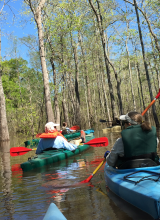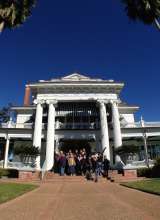- Home
- Things To Do
- Parks & Outdoors
- Parks
- Tyrrell Park
- Tyrrell Park Nature Center
- Gift Shop
- Big Thicket
- The Best Hiking Trails in the Big Thicket
- Water Activities
- Lakes and Rivers
- Neches River Boat Tours
- Kayaking and Canoeing in Beaumont
- Horseback Riding
- Botanical Gardens
- Beaumont in Bloom
- Fishing & Hunting
- Fishing Charters in Beaumont
- Golf
- Camping in Beaumont
- Agritourism
- Hiking
- Biking
- Beaucycles
- Birding
- Cattail Marsh
- Big Thicket
- Birding Package
- Beaumont Birdies
- Birder Mailing List
- Anahuac
- High Island
- Bolivar Flats
- Sabine Woods
- Galveston Island
- Creole Nature Trail
- Swamps & Gators
- Arts & Culture
- Performing Arts/Theater
- Galleries & Museums
- Murals and Visual Art
- 10 Best Instagram Spots
- SETX Selfie Scavenger Hunt
- Museums & Historic Sites
- Top Historic Spots
- Spindletop
- Museums
- Historic Homes
- Entertainment & Nightlife
- Casinos & Gaming
- Happy Hour
- Live Music
- Movie Theaters
- Bowling & Skating
- After Hours
- Sawdust Saloon
- Shopping
- Antiques
- Boutiques
- Gift Guide
- GoBeau Gifts
- Bolivar Beach
- Cattail Marsh
- Web Cam
- Wetlands Education Center
- Volunteer
- Roadside Attractions
- Things to Do with Kids
- Parks & Playgrounds
- Bowling & Skating
- Things to Do for Couples
- Girlfriend Getaway Ideas
- Things to Do Solo
- Dog-Friendly Attractions
- Beaumont Bucket List
- Bucket List Challenge
- LGBTQ Guide
- Geocaching
- 24-Hour Itinerary
- Wheelchair-Accessible Guide
- Multigenerational Itinerary
- Black History and Culture
- Home
- Restaurants
- Eat Local #EATBMT
- BBQ
- Burgers
- Mediterranean & Indian
- Tex-Mex
- Margaritas
- Pasta
- Pizza
- Sandwiches
- Seafood
- Street Tacos
- Sushi
- Vietnamese
- Family Friendly Restaurants
- Bars, Pubs & Breweries
- Breweries
- Wineries
- Dive Bars
- Sports Bars
- Outdoor Bar Scene
- Live Music
- Bakery & Cafe
- Happy Hour
- Best Beaumont Bites
- Patio Restaurants
- A-Z: A South Texas Cajun Food Guide
- Crawfish Spots
- Where to Find Gumbo
- Instagram Foods
- Favorite Foodie Restaurants
- Cajun Trail
- Cajun Trail FAQ
- Home
- Plan
- Visitors Guide
- Top 10 Reasons to Visit
- Trip Ideas
- Texas History Trail
- Faith Trail
- Black Gold Trail
- Pioneer Trail
- Adventure Seekers
- Festival Lovers
- 24-Hour Guide
- Nature Trail
- Insider's Guide
- Visitor Center
- Maps
- Transportation
- Jack Brooks Airport
- Weather
- eNewsletter
- Webcams
- FAQ
- Deals
- GoBeau
- Home
- Events
- Event Calendar
- Annual Events
- February: Mardi Gras of Southeast Texas
- March: Taste of the Triangle
- March: South Texas State Fair & Rodeo
- April - 409 Weekend
- April- Neches River Festival
- May- Neches River Rally
- October: Oktoberfest
- October: Dogtober Fest
- October: Museum Madness
- October- The Haunted Hotel
- December: Main Street Market
- December: Holidays in Beaumont
- December: Christmas in Boomtown: City in Lights
- Beaumont Mardi Gras
- Carnival
- Concerts
- Mardi Gras Attractions
- Capes and Crown 5K
- How to Get Involved
- Classic Movie Nights
- Farmers Market
- Neches River Boat Tours
- Submit Your Event
- Event Submission Policy
- Recurring Events
- Downtown Beaumont Junk Days
- Larry's Old Time Trade Days
- I-10 Flea Market
- Events This Weekend
Sabine Woods
Beaumont's Best Birding Secret
Privately owned and managed by local Audubon chapters, Sabine Woods is a shining example of a chenier plain. The slightly elevated beach ridge allows oak trees to grow along the coast, which attracts migrants in droves. The peak time to visit is late March-early May when the woodland is practically dripping in neotropical passersby’s. Many trails wind through the woods providing access to birds along with locally maintained water drips to entice even more.
Warblers, Vireos, Thrushes, Orioles, Flycatchers, Tanagers, and Cuckoos can be seen in stunning numbers if you get the right weather to produce a fallout. Standout species include Black-billed Cuckoo, Veery, and Gray-cheeked Thrush, Cerulean, Golden-winged, and Swainson’s Warblers, Summer and Scarlet Tanagers, Indigo and Painted Buntings, Blue Grosbeak, and Orchard and Baltimore Orioles. Sabine Woods is also the place to see grassland species such as Sedge Wren and other wading fowl because the site is surrounded by marsh. Both species of kinglets can be found in winter along with a handful of warblers like Black-and-white, Orange-crowned, and Yellow-rumped. The Hermit Thrush also winters here, along with a few dozen Greater White-fronted Geese, and a few hundred to thousand Snow Geese in the adjacent wetlands.
Birding Resources
Continue Birding along the Route
Texas Point National Wildlife Reserve provides further access to the saltmarsh and a large body of water, Clam Lake. Birds such as Seaside Sparrow and Clapper Rail can be seen along Cattlewalk Trail, while Pilot Station Road is a great location for Clapper Rail, Seaside Sparrow, and Nelson’s Sparrow in winter. Species such as Lesser Scaup and Red-breasted Merganser can be common in the ship channel that parallels the road. This location is good for species such as Common and Purple Gallinules as well as several species of waterfowl.
Pleasure Island offers birders road access to Sabine Lake, a great spot to scope for ducks, grebes, and seabirds. Best in winter and early spring, Ruddy Ducks can be particularly numerous but Northern Shoveler, Gadwall, Northern Pintail, Canvasback, Redhead, and a few others can also be seen, along with Horned and Eared Grebes, Ospreys, Bald Eagles, and the occasional Brown Boobie, Long-tailed Duck, and scoter.
Also birded from the road, Taylor Bayou Watershed and Hillebrandt Bayou Watershed are more good sites in winter and spring. Close to the coast, it is much different than the typical marsh and Gulf birding. Hillebrandt Bayou hosts thousands of Snow Geese with smaller numbers of Ross’s and Greater White-fronted Geese, along with species such as Broad-winged Hawk, Pileated Woodpecker, Barred Owl, and Wood Ducks.
• Major Birding Sites: Pilot Station Road, Texas Point National Wildlife Refuge
• Additional Areas: Pleasure Island, Taylor Bayou Watershed, Hillebrandt Bayou Watershed







